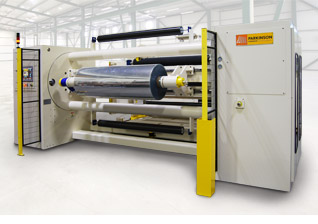

October 12 2018

Maintaining the proper web tension at the unwind is critical to the success of a web process. In most situations, two components work together to achieve and maintain the desired tension. In the previous article we discussed one of these components, the braking system, which plays the vital role of applying torque in proportion to the desired web tension. We will now focus our attention on the control system, which provides the required signals to the braking system to regulate the web tension. Control systems are open loop or closed loop and various configurations of each of these exist.
What are the differences between open and closed-loop tension control systems for unwind applications?
In the most basic form of open-loop systems, the operator manually sets the tension by continuously adjusting the braking torque as the unwinding roll’s diameter changes. This is accomplished by manually adjusting the supply pressure to the pneumatic brake, or in the case of a motor driven unwind, adjusting the torque setpoint to the drive. A more refined open-loop method is computer based and requires some upfront calibration during commissioning to determine how much braking torque is generated at the unwind spindle when a known supply pressure or motor torque is set. The control system uses this information to adjust the braking torque as the unwinding roll’s diameter changes. Without a direct measurement of this instantaneous diameter, an estimated diameter can be calculated by knowing how big the roll diameter was at the start, how thick the material is, and the length of material that has been unwound since the start.
Although the cost of this method is higher as the machine needs a computer-based control system and a device to measure the length of material that has been unwound, it’s not always perfect.Since the roll’s diameter is calculated in the program and not actually measured, improper entry of material thickness or starting diameter can lead to instability in web tension, which can cause variations in finished roll formation. An open-loop tension control system can be an economical alternative for less demanding applications, but to ensure finished roll quality, requires accurate operator entry of processing parameters plus the skills and experience needed to make real-time adjustments to the process.
A closed-loop system, also known as a feedback control system, uses some form of continuous tension measurement to automatically adjust commands to the braking system to maintain the desired web tension.It uses the concept of an open loop system as a forward path but uses tension feedback to compare to the tension setpoint value and makes automatic adjustments to maintain web tension without operator involvement. Feedback is most accurately accomplished with a force measuring roller installed in the web path to measure the actual force, or tension, that’s been applied to the web. This device, also called a loadcell roller, provides a signal to the control system that is compared to the desired setpoint and the process is adjusted to minimize the difference, or error between these two values.
Another feedback method is to use a translating dancer roller (more commonly pivoting but linear designs exist) that has been calibrated to exert a force to achieve a desired tension in the web, and uses a device to measure its position along its translating path. Because the force exerted is constant, any change in position is a result of either an increase or decrease in web tension. This position signal is then used in a similar manner as the loadcell signal to adjust the process to keep the dancer roller in a fixed position, oftentimes in the mid-stroke of its total travel. Although not a direct measure of how much tension is being applied to the web, if properly calibrated a dancer system can be used quite effectively in combination with a closed-loop tension control system to deliver web at a desired tension to the downstream process. The translating feature of a dancer can be an advantage in certain applications, such as automatic splicing unwind systems, to absorb minor tension disturbances that occur during the splicing sequence, and not create web handling defects.
The act of unwinding material into a downstream web process may seem simple on the surface, but to achieve the required tension control accuracy there are often more complex requirements that aren’t immediately apparent.If your process is being impacted by unstable unwinding tension, please contact us for assistance.